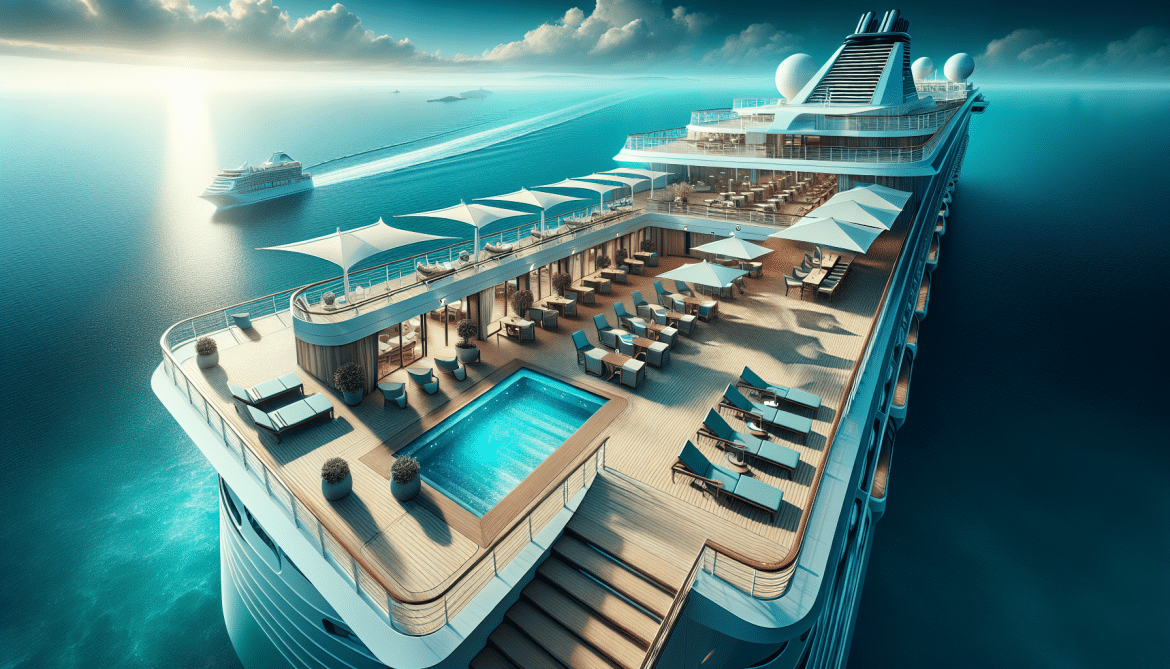Are you someone living with a disability and dreaming of embarking on a luxurious cruise vacation? Look no further! “A Comprehensive Guide to Accessible Cruising” is here to fulfill your dreams by providing an extensive resource to navigate the world of accessible cruising. From choosing the right ship to exploring accessible facilities and activities, this guide is your ultimate companion to ensure a seamless and enjoyable cruise experience. So, pack your bags and get ready to set sail on an unforgettable accessible adventure on the high seas!
Planning for an Accessible Cruise
Planning for an accessible cruise can ensure that you have a smooth and enjoyable vacation experience. From choosing the right cruise line to arranging wheelchair assistance, there are several factors to consider. By following these steps, you can make sure that your cruise is tailored to your specific accessibility needs.
Choosing the Right Cruise Line
The first step in planning an accessible cruise is to choose the right cruise line. Not all cruise lines are equally accommodating for passengers with disabilities, so it’s important to do your research. Look for cruise lines that offer a comprehensive range of accessibility services and facilities, such as accessible cabins, ramps, elevators, and accessible dining options. Consider reaching out to the cruise line directly to inquire about their accessibility policies and any additional assistance they can provide.
Researching Ship Accessibility
Once you have decided on a cruise line, it’s important to research the accessibility features of the specific ship you will be sailing on. Different ships within the same cruise line may have varying levels of accessibility, so it’s crucial to gather information about the ship’s layout, availability of accessible cabins, and accessibility features in common areas such as restaurants, pools, and entertainment venues. This research will help you make an informed decision about which ship best suits your accessibility needs.
Booking Accessible Accommodations
When booking your cruise, it is essential to request accessible accommodations. Accessible cabins are specifically designed to meet the needs of passengers with disabilities, offering features such as wider doorways, grab bars in bathrooms, and lowered sinks and wardrobes. By booking an accessible cabin, you can ensure that your living space onboard will be equipped with the necessary amenities to make your stay comfortable and convenient.
Arranging Wheelchair Assistance
If you require wheelchair assistance, it is crucial to inform the cruise line in advance. Most cruise lines offer wheelchair assistance services, both at the terminal and onboard the ship. By arranging for wheelchair assistance, you can have peace of mind knowing that trained staff will be available to assist you throughout your journey. It’s important to communicate your specific needs to the cruise line so that they can make the necessary arrangements to accommodate you.
Requesting Special Dietary Needs
If you have special dietary needs, it’s important to inform the cruise line ahead of time. Many cruise lines offer a variety of dining options to accommodate passengers with dietary restrictions or food allergies. By notifying the cruise line in advance, they can make the necessary arrangements to provide you with suitable dining options. Whether you require gluten-free meals, kosher cuisine, or have specific food allergies, it’s crucial to communicate your dietary needs to ensure a pleasant dining experience onboard.
Preparing for Your Cruise
Once you have completed the planning phase, it’s time to start preparing for your accessible cruise. By taking certain steps to prepare, you can ensure that you have everything you need for a comfortable and worry-free vacation.
Packing Essential Accessibility Aids
When packing for your accessible cruise, it’s important to include essential accessibility aids. These may include items such as a mobility scooter, cane, walker, or any other device that assists with your mobility. By bringing these aids with you, you can navigate the ship and its various facilities with ease and independence.
Packing Medications and Medical Supplies
If you have any medications or medical supplies, it’s crucial to pack them for your cruise. Ensure that you have an ample supply to last for the duration of your trip, as well as any necessary prescriptions or documentation. It’s also a good idea to bring a small first-aid kit with basic supplies for any minor medical needs that may arise during your cruise.
Informing the Cruise Line about Accessibility Requirements
Before you embark on your cruise, it’s important to inform the cruise line about your specific accessibility requirements. This includes notifying them of any special accommodations you may need, such as accessible transportation at ports or assistance with embarkation and disembarkation. By communicating your needs in advance, the cruise line can make the necessary arrangements to ensure a smooth and seamless experience for you.
Bringing Documentation for Assistance Animals
If you are traveling with an assistance animal, it’s essential to bring the necessary documentation. This may include a letter from your doctor or medical professional certifying the need for your assistance animal. It’s important to check the specific requirements of the cruise line regarding assistance animals, as some may have specific policies in place. Having the proper documentation will ensure that your assistance animal is allowed onboard and that you can fully enjoy your cruise experience.
Creating a Travel Itinerary
To make the most of your accessible cruise, it’s helpful to create a travel itinerary. This will allow you to plan out your days and ensure that you have enough time to participate in the activities and excursions that interest you. Research the ports of call and the available accessible attractions and landmarks in each destination. By having a well-planned itinerary, you can maximize your enjoyment and make the most of your time onboard and ashore.

This image is property of images.pexels.com.
Navigating the Cruise Terminal
Once you arrive at the cruise terminal, there are several steps to navigate before boarding the ship. By following these guidelines, you can easily navigate the terminal and ensure a smooth embarkation process.
Arriving at the Terminal
When you arrive at the cruise terminal, it’s important to follow the signage and instructions provided. Most terminals have designated areas for drop-off and parking, so make sure to follow the appropriate signs. If you require assistance from the terminal staff, don’t hesitate to ask for help. They are there to assist you and ensure a smooth embarkation process.
Using Special Assistance Services
Many cruise terminals offer special assistance services for passengers with disabilities. These services may include wheelchair assistance, priority check-in, and dedicated accessible facilities. It’s important to inquire about these services in advance and make use of them if needed. By utilizing the special assistance services, you can save time and energy during the embarkation process.
Checking in and Security Screening
Once inside the cruise terminal, you will need to proceed with the check-in and security screening process. Make sure to have all necessary travel documents, such as your passport and boarding pass, readily available. If you have any specific accessibility needs during the check-in process, inform the staff so that they can provide the necessary assistance. Security screening procedures may vary, but most terminals have systems in place to accommodate passengers with disabilities.
Boarding the Ship
After completing the check-in and security screening process, you will be ready to board the ship. Follow the instructions provided by the terminal staff and proceed to the designated boarding area. If you have any specific accessibility needs during the boarding process, inform the staff so that they can provide assistance. Once onboard, take some time to familiarize yourself with the ship’s layout and accessibility features.
Accessible Cabins and Amenities
Accessible cabins and amenities are designed to provide comfort and convenience to passengers with disabilities. By choosing the right accessible cabin and making use of the available amenities, you can ensure a pleasant stay onboard.
Overview of Accessible Cabin Features
Accessible cabins are equipped with a range of features to accommodate passengers with disabilities. These may include wider doorways, grab bars in bathrooms, accessible wardrobes and sinks, and lowered peepholes and thermostat controls. Familiarize yourself with the specific features of your accessible cabin to make the most of its accessibility benefits.
Choosing the Right Accessible Cabin
When selecting an accessible cabin, consider your specific mobility needs and preferences. There are different types of accessible cabins available, including those with roll-in showers, adapted bathrooms, and/or spacious layouts. It’s important to review the cabin options carefully and choose the one that best meets your needs. Keep in mind that accessible cabins are in high demand, so it’s advisable to book well in advance to secure your preferred cabin.
Adaptable Bathroom Facilities
Accessible cabins are designed to provide convenient bathroom facilities for passengers with disabilities. These may include roll-in showers with grab bars, adjustable showerheads, and fold-down shower benches. It’s important to familiarize yourself with the specific bathroom facilities in your cabin and any additional equipment that may be available upon request. By utilizing the adaptable bathroom facilities, you can maintain your independence and comfort throughout your cruise.
Assistive Devices and Equipment Rentals
If you require assistive devices or equipment during your cruise, many cruise lines offer rentals or have equipment available onboard. This may include items such as wheelchairs, scooters, or shower chairs. It’s important to inquire about equipment rentals in advance and make any necessary arrangements. Having access to assistive devices can enhance your mobility and accessibility throughout your cruise.
Accessible Recreation and Entertainment
Cruise ships offer a wide range of recreational activities and entertainment options for passengers. Many of these activities and venues are designed to be accessible to passengers with disabilities. From accessible pools and hot tubs to fully accessible theaters and lounges, there’s something for everyone to enjoy. When planning your onboard activities, consider your accessibility needs and choose options that will cater to your specific requirements.

This image is property of images.pexels.com.
Dining and Dietary Needs
Cruise ships offer a variety of dining options to cater to passengers with special dietary requirements. By communicating your needs to the cruise line and taking advantage of the available options, you can enjoy a satisfying dining experience onboard.
Options for Special Dietary Requirements
Cruise lines are well-equipped to accommodate passengers with special dietary requirements. They offer a range of dining options, including vegetarian, vegan, gluten-free, and kosher meals. Whether you have allergies, specific dietary restrictions, or religious dietary needs, the cruise line can provide suitable dining options to ensure your satisfaction.
Dining Room Accessibility
The dining rooms onboard cruise ships are designed to be accessible to passengers with disabilities. This includes accessible seating options, wide aisles for wheelchair access, and staff trained to assist passengers with specific needs. When dining in the ship’s main dining room, communicate your accessibility needs to the staff so that they can provide appropriate assistance and ensure a pleasant dining experience.
In-Room Dining Options
If you prefer to dine in the privacy of your own cabin, most cruise lines offer in-room dining options. This allows you to enjoy your meals in the comfort of your accessible cabin. By utilizing the in-room dining service, you can have your meals delivered at your preferred time and enjoy a relaxed dining experience without having to venture to the ship’s restaurants.
Allergies and Food Sensitivities
If you have allergies or food sensitivities, it’s important to communicate your dietary needs to the cruise line. They can provide you with information about ingredients and help you make informed dining choices. You may also want to inquire about allergen-free menu options or request special meal preparations to ensure that your dietary needs are met during your cruise.
Communicating Dietary Needs to Staff
To ensure that your dietary needs are met, it’s important to communicate your requirements to the ship’s staff. This can be done in advance when booking your cruise or upon embarkation. By informing the staff about your dietary needs, they can provide the necessary accommodations to ensure a satisfying dining experience.
Accessibility on Board
Once onboard the cruise ship, it’s important to familiarize yourself with the ship’s layout and accessibility features. This will enable you to navigate the ship with ease and take advantage of the various accessible facilities and amenities.
Navigating the Ship’s Layout
Cruise ships can be large and have multiple decks, so it’s helpful to familiarize yourself with the ship’s layout. Study the ship’s map and take note of the location of accessible facilities such as elevators, ramps, accessible restrooms, and dining venues. By planning your route and identifying accessible pathways, you can navigate the ship more efficiently.
Access to Common Areas
Cruise ships offer a variety of common areas for passengers to relax and socialize. These may include lounges, theaters, casinos, and libraries. Many of these common areas are designed to be accessible to passengers with disabilities, with features such as accessible seating, ramps, and elevators. Enjoy these areas at your leisure and take advantage of the accessible facilities provided.
Elevators and Ramps
Cruise ships are equipped with elevators and ramps to facilitate accessibility between decks. It’s important to utilize these accessibility features when navigating the ship. Be mindful of elevator etiquette, allowing priority access for passengers with mobility challenges, and be patient during peak times when there may be higher demand for these facilities.
Accessible Pools and Hot Tubs
If you enjoy swimming or relaxing in a hot tub, cruise ships offer accessible pool and hot tub options. These facilities are designed with features such as lifts or ramps to provide easy access for passengers with disabilities. Take advantage of these accessible amenities and enjoy some leisure time by the pool or in the hot tub.
Accessible Fitness and Spa Facilities
Cruise ships often have fitness centers and spa facilities onboard. These venues are typically designed to be accessible to passengers with disabilities, with features such as adapted exercise equipment and accessible treatment rooms. Whether you want to stay active or indulge in some relaxation, the ship’s fitness and spa facilities can cater to your accessibility needs.

This image is property of images.pexels.com.
Shore Excursions and Ports
One of the highlights of a cruise vacation is the opportunity to explore various ports of call. When planning shore excursions and activities, it’s important to consider your accessibility requirements to ensure a fulfilling and enjoyable experience.
Researching Accessible Excursion Options
Before arriving at each port of call, it’s helpful to research the available accessible excursion options. Many cruise lines offer shore excursions specifically designed for passengers with disabilities. These excursions may involve accessible transportation, adapted facilities, and guides trained in assisting passengers with mobility challenges. By researching and booking accessible excursions in advance, you can make the most of your time ashore.
Booking Excursions with Accessibility in Mind
When selecting a shore excursion, consider your accessibility requirements and choose activities that can accommodate them. Whether you want to explore historical landmarks, enjoy a scenic tour, or engage in adventurous activities, there are likely accessible options available. Make your reservations in advance to secure your spot and inform the excursion provider about any specific requirements or assistance you may need.
Communicating Accessibility Requirements
When booking shore excursions, it’s important to communicate your accessibility requirements to the excursion provider. This can include notifying them about your mobility needs, assistance with boarding transportation, or any other accommodations you may require. By providing this information in advance, the excursion provider can make the necessary arrangements to ensure a seamless and enjoyable experience for you.
Transportation at Ports
When going ashore at each port, it’s important to consider transportation options that are accessible to you. Many ports provide accessible transportation services, such as accessible buses or vans. Research the availability of accessible transportation and communicate your needs to the cruise line or port authorities. By planning ahead, you can ensure that transportation is readily available to facilitate your exploration of the port.
Accessible Attractions and Landmarks
Each port of call offers unique attractions and landmarks to explore. It’s important to research the accessibility of these attractions to ensure that they can accommodate your needs. Many landmarks and tourist sites have implemented accessibility measures to ensure that all visitors can fully enjoy their experience. By researching accessible attractions in advance, you can plan your itinerary accordingly and make the most of your time at each port.
Emergency Preparedness
While no one wants to think about emergencies during a vacation, it’s important to be prepared. Familiarize yourself with the cruise line’s emergency procedures and communicate your assistance needs to the staff to ensure your safety and well-being.
Reviewing the Cruise Line’s Emergency Procedures
The cruise line will have established emergency procedures in place to ensure the safety of all passengers, including those with disabilities. It’s important to familiarize yourself with these procedures, including evacuation routes, muster station locations, and communication protocols. Review the safety information provided in your stateroom and attend any mandatory emergency drills or briefings. By being prepared, you can respond effectively in the event of an emergency.
Informing Staff about Assistance Needs
If you require assistance during an emergency, it’s important to communicate your needs to the cruise line staff. Whether you have mobility challenges, sensory impairments, or any other specific needs, notify the staff so that they can provide the necessary assistance and support. By informing the staff in advance, they will be prepared to accommodate your needs and ensure your safety during an emergency situation.
Safety Features in Accessible Cabins
Accessible cabins are equipped with safety features to ensure your well-being during an emergency. These may include emergency call buttons, visual and audible alarm systems, and accessible doorways to evacuate with ease. Familiarize yourself with the safety features in your cabin and know how to use them in case of an emergency.
Accessibility during Emergency Drills
Cruise lines conduct mandatory emergency drills for all passengers. These drills are designed to familiarize you with emergency procedures and safety protocols. As a passenger with disabilities, it’s crucial to participate in these drills to ensure you are aware of the necessary steps to take in the event of an emergency. If you have any specific needs during the drill, inform the staff beforehand so that they can provide the necessary assistance.
Accessible Evacuation Procedures
In the unlikely event of an emergency requiring evacuation, the cruise line will have procedures in place to ensure the safe evacuation of all passengers. If you have mobility challenges, sensory impairments, or other specific needs, it’s important to communicate these to the staff. The cruise line will have accessible evacuation procedures and assistance available for passengers with disabilities to ensure their safe evacuation from the ship.
Communication and Assistance
Throughout your cruise, it’s important to communicate your needs to the ship’s staff and take advantage of the available assistance services. By doing so, you can ensure a comfortable and enjoyable experience onboard.
Interacting with the Ship’s Staff
The ship’s staff are available to assist you throughout your cruise. From dining room waitstaff to housekeeping and guest services, the staff are trained to provide a high level of service, including assistance for passengers with disabilities. If you require any assistance or have any specific needs during your cruise, don’t hesitate to communicate them to the ship’s staff. They are there to ensure your comfort and satisfaction.
In-Room Accessibility Features
Accessible cabins are equipped with various in-room accessibility features to cater to passengers with disabilities. These may include visual and audible alarm systems, accessible controls and switches, and lowered fixtures. Familiarize yourself with these features and know how to operate them to ensure your convenience and comfort during your stay onboard.
Accessible Information and Signage
Cruise ships provide accessible information and signage to assist passengers with disabilities. This may include Braille signs, tactile maps, and information in large print or accessible electronic formats. If you require any specific accessibility aids or materials, don’t hesitate to reach out to the ship’s staff for assistance. They can provide the information you need to navigate the ship and access the available services and amenities.
Attendant Care Services
If you require attendant care services during your cruise, it’s important to communicate your needs to the cruise line in advance. Some cruise lines offer attendant care services for passengers with disabilities, providing additional support and assistance as needed. By arranging for attendant care services, you can have peace of mind knowing that you will have the necessary assistance throughout your journey.
Communication Aids for Deaf and Hard of Hearing
For passengers who are deaf or hard of hearing, cruise lines offer various communication aids to ensure effective communication. This may include assistive listening devices, closed captioning services, and sign language interpreters. Notify the cruise line in advance about your communication needs so that they can make the necessary arrangements to ensure your communication access throughout your cruise.
Disembarkation and Departure
As your cruise comes to an end, it’s important to plan for a smooth disembarkation process. By following these steps, you can ensure a stress-free departure and a seamless transition back to your home or onward travel.
Assistance with Disembarkation
If you require assistance with disembarkation, it’s important to notify the cruise line in advance. They can provide the necessary assistance, whether it’s wheelchair assistance or additional support during the disembarkation process. By informing the cruise line about your needs, they can ensure that you have a comfortable and efficient departure from the ship.
Navigating the Cruise Terminal
Once you have disembarked from the ship, you will need to navigate the cruise terminal to reach your final destination. Follow the signage and instructions provided, and don’t hesitate to ask for assistance if needed. Many cruise terminals offer accessible facilities and services to ensure a smooth transition from ship to shore.
Returning Wheelchairs and Equipment Rentals
If you have rented any assistive devices or equipment during your cruise, make sure to return them to the designated location in the cruise terminal. Check with the cruise line about the specific process for returning rented equipment, ensuring that you have returned everything before leaving the terminal. This will prevent any additional charges and ensure a smooth end to your cruise experience.
Arranging Transportation after the Cruise
After disembarking from the ship, you will need to arrange transportation to your next destination. Whether you have a flight to catch or are continuing your journey by another mode of transportation, it’s important to plan ahead. Many cruise lines offer assistance with post-cruise transportation, so inquire about these services in advance. If you require accessible transportation, communicate your needs to ensure that appropriate arrangements are made.
Providing Feedback to the Cruise Line
After your accessible cruise, take the time to provide feedback to the cruise line. Share your experiences, both positive and areas for improvement, with the cruise line’s customer service department. By providing feedback, you can help the cruise line enhance their accessibility services and facilities, ensuring an even better experience for future passengers with disabilities. Your valuable input can contribute to the continued improvement of accessible cruising for all.

